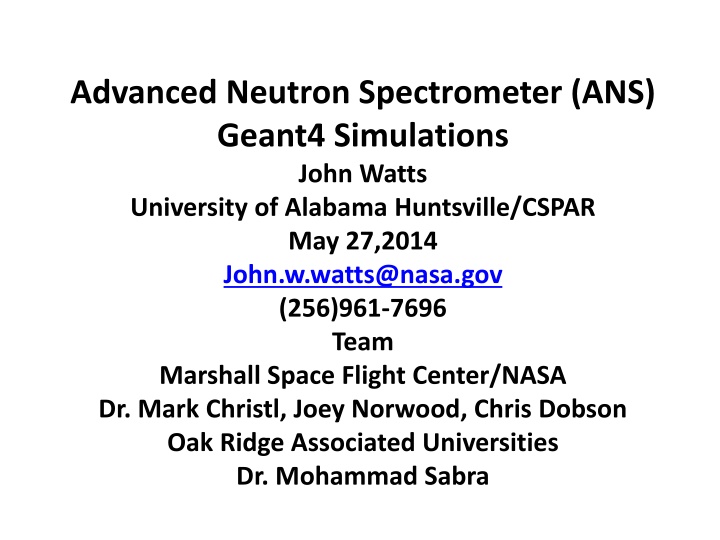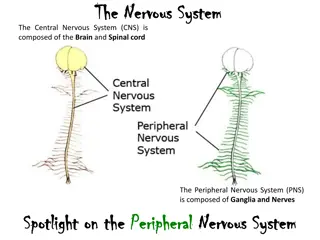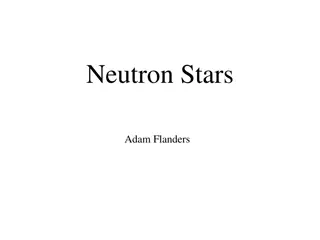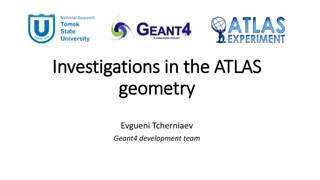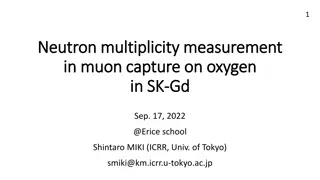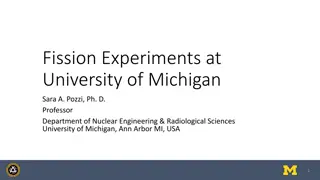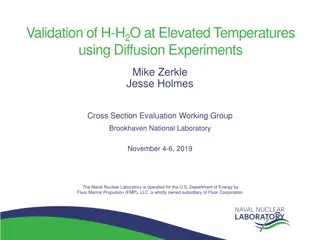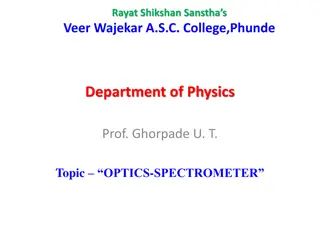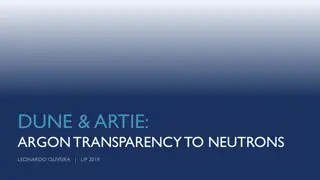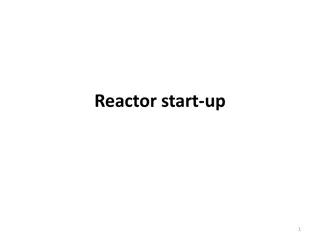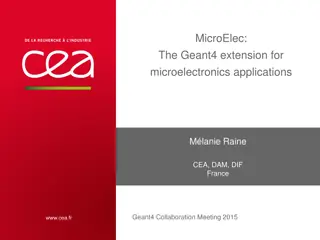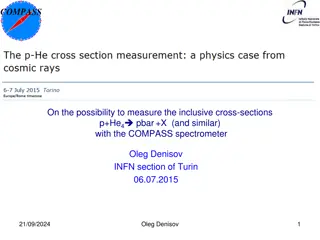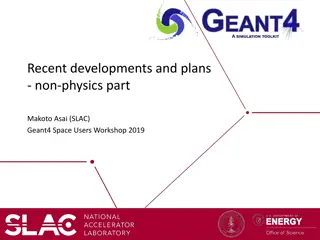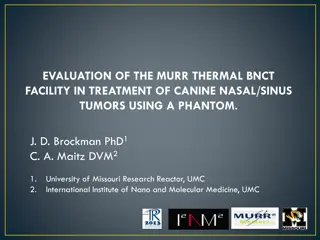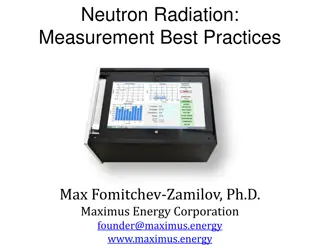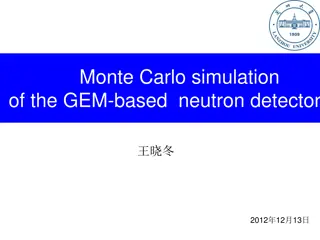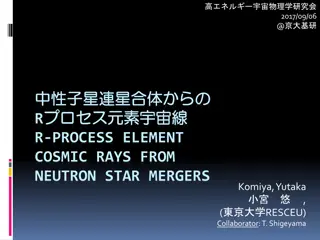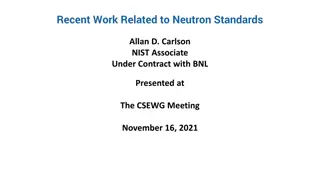Advanced Neutron Spectrometer (ANS) Geant4 Simulations Overview
A Geant4 application has been developed to simulate the response of the Advanced Neutron Spectrometer (ANS) and investigate meeting the instrument requirements. The simulation involves a scintillator-based detector with photomultiplier tubes, lithium glass fibers for neutron capture, and optical processes for energy deposition. The code structure and physics list used in the simulations are detailed to understand the optical characteristics and response of the detector components in capturing neutron events.
Download Presentation

Please find below an Image/Link to download the presentation.
The content on the website is provided AS IS for your information and personal use only. It may not be sold, licensed, or shared on other websites without obtaining consent from the author.If you encounter any issues during the download, it is possible that the publisher has removed the file from their server.
You are allowed to download the files provided on this website for personal or commercial use, subject to the condition that they are used lawfully. All files are the property of their respective owners.
The content on the website is provided AS IS for your information and personal use only. It may not be sold, licensed, or shared on other websites without obtaining consent from the author.
E N D
Presentation Transcript
Advanced Neutron Spectrometer (ANS) Geant4 Simulations John Watts University of Alabama Huntsville/CSPAR May 27,2014 John.w.watts@nasa.gov (256)961-7696 Team Marshall Space Flight Center/NASA Dr. Mark Christl, Joey Norwood, Chris Dobson Oak Ridge Associated Universities Dr. Mohammad Sabra
ANS Geant4 Simulations Introduction A Geant4 application has been developed to simulate the response of the Advanced Neutron Spectrometer (ANS) and to investigate approaches to meeting the instrument requirements over the proposed energy range (0.1 to 100 MeV). The configuration shown in Figure 1 consisted of a volume of scintillator-doped vinyltoluene 10 inches long with a 2x2 inch readout photomultiplier tube (PMT) on each end. The ends are 4x4 inches, and the center is 5 x5 inches. An array of 120-micrometer diameter lithium glass fibers are embedded in the plastic scintillator. The arrays has a 1 mm pitch with 72x72 fibers which yields a mass fraction of 3% in the array region. The photomultiplier tubes count the optical photons produced by scintillation as energetic charged secondary particles deposit energy in the scintillation plastic or glass fibers. These are created when the primary neutrons undergo elastic and inelastic scatter and neutron capture.
ANS Geant4 Simulations Figure 1 ANS diagram
ANS Geant4 Simulations Neutron Capture For the embedded lithium glass scintillator, neutron captures are identified by the energy released and then deposited by secondary particles. The fibers are composed of 20% Li2O-15% MgO-64.4%SiO2-0.6%Ce2O3 with the lithium being 95% 6Li. Neutrons are captured in the glass which has different scintillation characteristics in terms of spectral output and timing from vinyltoluene scintillator. The capture interaction here is ? + where the triton energy is 2.734 MeV and the energy is 2.105 MeV. To reach energies where this interaction is probable the neutron must be at near thermal energies having lost energy through elastic scattering. In vinyltoluene (C10H11) most of the energy is lost through elastic scatters with the hydrogen or less frequently the carbon. The ions produced interact, depositing their energy and generating scintillation photons. The approach in ANS is to identify the unique light pulse associated with a neutron capture event and use the total light produces previously in the event as a measure of primary neutron energy deposited in the detector volume. 6?? ? + ??????
ANS Geant4 Simulations Code Structure Geant4.10.p01 with multithreading enable was used for the simulations. The physics list was QGSP_BIC_HP with the addition of optical processes. A GDML description of the ANS geometry and the appropriate materials was constructed for input into a Geant4 simulation tailor to transport neutron and describe the response of the various parts of the detector in detail. A key part of the simulation is the description of the optical characteristics of the scintillator material, the scintillator volume surface characteristics, and the optical coupling between the scintillator and the photomultiplier tube. In Geant4 optical photons are treated a separate particle from x-rays and gamma particles. They can be affected by several processes, but in this simulation only scintillation, Cerenkov, and attenuation processes are included. To create and transport them, tables of the index of refraction and attenuation length in the optical materials are required together with the scintillation yield, scintillation time constants, and Birks parameters. The characteristic of the optical interface between the scintillator volume with the world and with the PMT must also be defined. These are largely based on data from a Bicron data sheet[1] for their BC-400 plastic scintillator and reference 2 for the scintillating glass.
ANS Geant4 Simulations Code Structure For the simulations show here a beams of neutrons at a selected set of energies were fired at normal incidence on the center of the positive Z face of the detector. (The center of the world coordinates is at the center of the plastic scintillator volume and the PMT s are on the positive and negative Z faces.) For each event a number of parameter were scored. These are tabulated in a ROOT format file for analysis and plotting using the g4tools header package. After the Geant4 simulation generates a set of events, analysis code written in C++ ROOT macros is used to impose various cut and plot the detector response and statistical measures. Figure 2 shows the mean energy response from 10 ev to 200 MeV. (The number of events was 107.)
Mean Neutron Energy Deposited Before Capture 60 50 Energy Deposit (MeV) 40 30 20 10 0 0 20 40 60 80 100 120 140 160 180 200 Neutron Energy (MeV) Figure 2 Mean energy response for an ANS detector.
Fraction of Neutrons Seen 1 Efficiency (fraction) 0.1 0.01 0.001 0 20 40 60 80 100 120 140 160 180 200 Neutron Energy (MeV) Figure 3 Number of neutron captures per incident neutron for an ANS detector. Note that the number of captures per event is low especially at higher energies because the neutron scatter length is relatively large compared to the detector size. Thus most neutrons escape the detector volume before undergoing a capture. This means that a large number of events must be simulated to get good statistics.
ANS Geant4 Simulations Results Geant4 allow control over the order in which secondary particles are simulated through a stack and staging mechanism. To improve the efficiency of the simulation a StackingAction class was used where: First, the primary neutron and any secondary neutrons were transported while other secondaries were put on a suspended stack. Then, in the second stage event process is continued only where one or more of the neutrons had a capture process. If there were no captures the event is killed.
ANS Geant4 Simulations Results Figures 4, 5, 6, 7, 8, and 9 show the energy deposition in the detector volume for events that had one or more neutron captures. Energy deposited by the neutron capture secondaries is excluded. The sharp peak (red) at the initial neutron kinetic energy is due to neutron that deposited most of their energy through elastic scatters in the detector plastic. The peak (green) at 5.3 MeV in Figure 6 (10 MeV) and 15.5 MeV in Figure 7 (19.9 MeV) are due to neutron breakup of a carbon atom by the reaction ? + The binding energy is ~4.5 MeV. The peak (blue) at 12.7 MeV in Figure 8 is due to the reaction ? + The binding energy is ~7.3 MeV. The peak (pink) at 14 MeV in Figure 9 is due to the reaction ? + The binding energy is ~16 MeV. Event from these colored peaks were tagged and their photon response plotted separately in the photon response plots shown later. 12? 9?? + ? 12? ? + 3? 12? 11? + ?
Figure 4 Fraction events versus energy deposited in the ANS detector volume for an incident neutron energy of 10 eV before neutron capture.
Figure 5 Fraction events versus energy deposited in the ANS detector volume for an incident neutron energy of 1 MeV before neutron capture.
Figure 6 Fraction events versus energy deposited in the ANS detector volume for an incident neutron energy of 10 MeV before neutron capture.
Figure 7 Fraction events versus energy deposited in the ANS detector volume for an incident neutron energy of 19.9 MeV before neutron capture.
Figure 8 Fraction events versus energy deposited in the ANS detector volume for an incident neutron energy of 20 MeV before neutron capture.
Figure 9 Fraction events versus energy deposited in the ANS detector volume for an incident neutron energy of 30 MeV before neutron capture.
Mean PMT Photon Current Before Capture 16000 Mean Photon Current (Photons) 14000 12000 10000 8000 6000 4000 2000 0 0 20 40 60 80 100 120 140 160 180 200 Neutron Energy (MeV) Figure 10 Optical photon response of the ANS detector versus incident neutron energy The detector energy response is measures by counting the optical photons emitted through scintillation with PMTs coupled to the end faces of the plastic scintillator volume. (Scintillation photons produced during capture are excluded.) The mean detector optical photon response versus incident neutron energy is shown.
ANS Geant4 Simulations Results Figures 11, 12, 13, 14, and 15 show the optical photon response distribution for energies 1, 10, 19.9, 20, and 30 MeV for the ANS detector. Photons from before the capture are scored. (No photons are produced before capture for at 10 eV because there is not enough kinetic energy available.) The colored curves are for the specific identified peaks in the energy deposit graphs shown previously.
Figure 11 ANS detector optical photon response distribution for 1 MeV neutrons before neutron capture.
Figure 12 ANS detector optical photon response distribution for 10 MeV neutrons before neutron capture.
Figure 13 ANS detector optical photon response distribution for 19.9 MeV neutrons before neutron capture.
Figure 14 ANS detector optical photon response distribution for 20 MeV neutrons before neutron capture.
Figure 15 ANS boron-doped detector optical photon response distribution for 30 MeV neutrons before neutron capture.
ANS Geant4 Simulations Neutron Time to Capture When neutron enter the detector they will not have a capture interaction until they have loss most of their energy and reached near thermal energies where the capture cross section is large. The time require to thermalize defines how far back in time one must look to see the photons produced during this energy deposition. Figures 16 shows the distribution of time to capture at a neutron energy of 1 MeV. The time for 95% capture was 45 microsecond over all energies.
Figure 16 ANS lithium-glass detector time to capture for 1 MeV neutrons.
Comparison of CPU time using MPI versus Multi-threading for the ANS Geant4 Simulation The operating system used was Scientific Linux 6.4 with gcc 4.4.7 and open MPI. The machine had two 8-core Xeon ES-2650 cpu s running at 2 GHz with 65920 MB of memory. There were 16 MPI processes or 16 threads. MPI (10000000 events) Multi-Threaded (1000000 events) MPI/MTh Neutron Energy (MeV) 1.00E-005 0.1 0.5 1 5 10 15 19.9 20 25 30 35 40 User Time (s) 274335 115432 76169 71829 66096 62948 59392 53508 48974 65466 Real Time (s) 274495 115476 76202 71861 66124 62975 59420 53538 48992 65493 System Time (s) 59.1 6.1 4.4 5.4 5.2 5.3 4.6 4.9 4.1 5.1 User Time (s) 36955 13759 9970 8514 7691 7177 7435 6604 6419 7107 7418 4736 5644 Real Time (s) 2313 861 624 533 482 450 467 416 404 448 467 300 357 System Time Comparison (s) 9.2 4.0 2.8 3.6 2.7 4.0 3.5 3.9 4.7 4.5 2.9 3.2 4.1 0.7 0.8 0.8 0.8 0.9 0.9 0.8 0.8 0.8 0.9 Average 0.8
ANS Geant4 Simulations References 1. Bicron, Bicron Organic Brochure . 2. M. Bliss, et al., Relationship between Microstructure and Efficiency of Scintillating Glasses , Mat. Res. Soc. Proc. Vol. 348, pp. 195-202, 1994.
